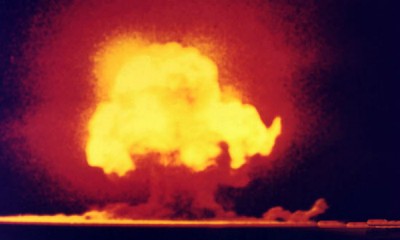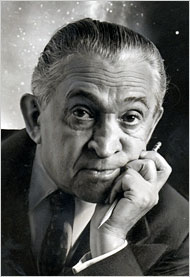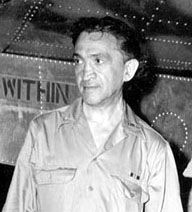
Alamagordo atomic test, July 15, 1945 (photo: Jack Abbey)
The New York Times‘ longtime nuclear power reporter, Matthew Wald, has announced that he’s been hired as the senior director of policy analysis and strategic planning for the Nuclear Energy Institute, the chief lobbying arm of the nuclear industry. Investigative reporter Karl Grossman wrote a piece a few years ago on the ties between the Times and the nuclear power establishment that go back to the dawn of the Atomic Age.
The model of a journalist being co-opted by the nuclear establishment involves New York Times reporter William L. Laurence. News Zero: The New York Times and The Bomb, by Beverly Deepe Keever, writes of how Gen. Leslie Groves, director of the Manhattan Project, personally made arrangements with Times publisher Arthur Hays Sulzberger and senior editor Edwin James to have Laurence work for the World War II program to build atomic
bombs.
The Times man would be paid by the government while, under the arrangement, his wife would collect “his regularly weekly salary” from the Times.
“To sell the bomb, the US government needed the Times…and the Times willingly obliged,” writes Keever, professor of journalism at the University of Hawaii.
 William L. Lawrence (photo: Arnold Newman/NYT) Laurence was central to the first major piece of official government media disinformation about nuclear technology. When it came time for a test of a nuclear device, in July 1945, Laurence wrote a press release to “disguise the detonation and resulting radiation,” notes Keever.
The deceptive release stated:
A remotely located ammunition magazine containing a considerable amount of high explosives and pyrotechnics exploded…. Weather conditions affecting the content of gas shells exploded by the blast made it desirable for the Army to evacuate temporarily a few civilians from their homes.
The purported source of the information was given in the release as “the commanding officer of the Alamagordo Army Air Base.”
The atomic device was detonated on July 16, 1945, at the Alamagordo Test Range in New Mexico. It lit up the night sky. The flash “was seen in Albuquerque, Santa Fe, Silver City and El Paso,” relates James Kunetka in his book City of Fire.
Meanwhile, the Manhattan Project had “stationed” an intelligence officer, Phil Belcher, at the Associated Press office in Albuquerque, states City of Fire. After AP began receiving calls about “a strange explosion in southern New Mexico,” Belcher presented the Laurence press release to AP, and AP ran it—basically as is. “New Mexico newspapers ran the story” and “it appeared in a number of radio shows,” says City of Fire. “No further word was issued by the Alamagordo Base.”
 William Laurence before the bombing of Hiroshima (Wikimedia) Timesman Laurence didn’t stop with this deception. At the Manhattan Project, he prepared a 10-part series glorifying it, and after the bombs fell on Japan, the Times itself ran the series “on behalf of the government” and distributed it free “to the press nationwide,” notes News Zero. The series hardly mentioned the word radioactivity at all.The Times was chosen by Groves not because of its circulation. “The Times was hardly the nation’s biggest newspaper then terms of circulation,” notes Keever. But “the prestige of the Times was highly significant for the government that was seeking to channel first-time-ever public attitudes about the atomic bombs it was developing.” Of Laurence, she writes, “this major player served as a scribe writing government propaganda.”
Laurence boosted all things nuclear in the years ahead. He would describe nuclear power as “making the dream of the Earth as a Promised Land come true.” This avid belief in nuclear power became the institutional stance of the publication.
The Times, writes Keever, “became little more than a propaganda outlet for the US government.” It
tolerated or aided the US government’s Cold War cover-up that resulted in minimizing or denying the health and environmental effects arising from the use in Japan and later testing of the most destructive weaponry in US history in Pacific Islands once called paradise…. The Times aided the US government in keeping in the dark thousands of US servicemen, production workers and miners, even civil defense officials, Pacific Islanders and others worldwide about the dangers of radiation.
Keever, herself a veteran journalist, says that “from the dawn of the atomic-bomb age, Laurence and the Times almost single-handedly shaped the news of this epoch and helped birth the acceptance of the most destructive force ever created.”
This pro-nuclear stance of the New York Times has continued, with the US paper of record leading US media in recent years in pushing for a “revival” of nuclear power.
And after the nuclear power disaster in Japan, the Times was still at it. It acknowledged in an editorial (3/14/11) that it has “endorsed nuclear power” and went on: “We suspect that, when all the evidence is in from Japan, it will remain a valuable tool.” That said by a long-time tool of the nuclear establishment—theNew York Times.
Karl Grossman is an investigative reporter, a journalism professor at SUNY/Old Westbury and a FAIR associate. A version of this piece appeared on his blog (3/26/11).
|